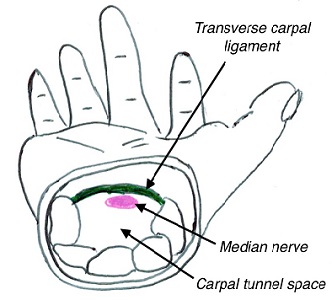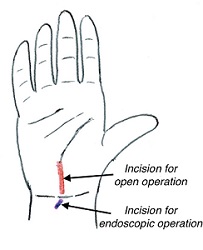Inside This section
Carpal Tunnel Syndrome
What Is Carpal Tunnel Sydnrome (C.T.S.)?
Carpal tunnel syndrome is a condition of the hand caused by compression of the median nerve as it passes through a tunnel on the front part of the wrist, called the carpal tunnel.

What are the symptoms?
Symptoms often include numbness and tingling in the tips of the thumb and fingers. Patients often wake at night with these symptoms, and have to shake their hands to get sensation back. Patients often complain of dropping objects and feeling their hands go to sleep. In advanced disease, the symptoms become constant and more severe. It can lead to loss of muscle bulk around the thumb area.
What Causes Carpal Tunnel Syndrome?
Carpal tunnel syndrome may be associated with several other conditions, such as rheumatoid arthritis, diabetes, obesity or wrist fractures. It is more common in women, and most common around 30-60 years of age. Certain activities may also predispose or cause carpal tunnel syndrome, in particular those which have repetitive motions or put constant pressure at the base of the palm.
How is the diagnosis made?
Carpal tunnel syndrome may be associated with several other conditions, such as rheumatoid arthritis, diabetes, obesity or wrist fractures. It is more common in women, and most common around 30-60 years of age. Certain activities may also predispose or cause carpal tunnel syndrome, in particular those which have repetitive motions or put constant pressure at the base of the palm
How is the diagnosis made?
Diagnosis is usually easily made on history and examination. However, nerve conduction studies can be useful in some cases. X-rays are also useful when looking for specific causes of carpal tunnel syndrome or when planning certain operations.
How is Carpal Tunnel Syndrome treated?
Treatment depends on the severity of the condition. Initial treatment may consist of splints or injections of corticosteroids into the carpal tunnel. Splints are worn at night time only. Avoiding aggravating activities or optimising associated medical conditions may also assist. For disease which has not responded to non-surgical treatments, or in severe disease, then an operation may be advised. In very severe disease, permanent nerve damage may result if the nerve is not decompressed urgently. Surgical carpal tunnel release is aimed to decompress the median nerve by cutting the transverse carpal ligament, which is lying tightly over the median nerve.
- Open carpal tunnel release: This is the standard surgical technique for this condition. An incision is made in the palm over the carpal tunnel and the transverse carpal ligament is released. This operation has an excellent success rate and a relatively low complication rate. It can be performed under local anaesthetic instead of a general anaesthetic.
- Endoscopic carpal tunnel release: This is a minimally-invasive procedure where a small incision is made at the front of the wrist. A camera is inserted allowing a view of the carpal tunnel from inside. The transverse carpal ligament is then released from below. This procedure has a smaller scar and is associated with quicker return to function than an open procedure. However, there is a slightly high complication rate reported with this operation, and it cannot be performed under local anaesthetic alone.

What to expect after the operation:
Carpal tunnel release is performed as a day-only procedure. A bulky dressing will be applied to the surgical site in the operating room. For open procedures, this dressing should be kept on and dry until the post-operative appointment.
For endoscopic procedures, this bulky bandage can be taken off one or two days after the operation. An underlying waterproof dressing will be in place and should be left in place. At this stage the hand may start getting wet under running water. Within a few days of the operation you would usually visit a therapist to start some exercises. It is important that you follow instructions to get the wrist and hand moving, and for wound care.
The immediate operation pain will subside within weeks and patients can usually return to full duties within 3-4 weeks for endoscopic procedures and 6-8 weeks for open procedures. Some milder aching pain (known as pillar pain) will remain for up to 9 months.
Patients usually find that some symptoms, such as tingling and waking at night, resolve within several days of the operation. Other symptoms, such as numbness and weakness, can take a year to resolve, and sometimes never resolve in severe disease. Muscle wasting almost never fully recovers.
There is no difference in final outcome when comparing open versus endoscopic carpal tunnel release after 12 months.
What are the risks of surgery?
Complications from carpal tunnel surgery are uncommon. The usual risks are:
- bleeding
- infection
- nerve, tendon or blood vessel damage
- stiffness
- Ongoing pain. It is common to get some mild to moderate soreness in the palm for 9 months following surgery.
- Ongoing numbness. This takes up to 12 months to recover and may be permanent in severe disease.
- Ongoing weakness. This takes up to 12 months to recover and may be permanent in severe disease
- Complex regional pain syndrome
- The symptoms may recur in future.
